Roger J. Wendell
Defending 3.8 Billion Years of Organic EvolutionSM


 |
Bharat The Republic of India and the Indian subcontinent Our November/December 2008 trip through one of the world's most fascinating countries! |

|
Click Here for my India "Two" overflow page! |
India is the seventh-largest country by geographical area (1,269,210 sq miles), making it about one-third the size of the United States. India is the world's largest democracy and is comprised of 28 states and seven union territories. At 1.2 Billion people it is second in population but expected to surpass China in the next decade or so.India's culture is extraordinarily diverse with Hinduism, Buddhism, Jainism and Sikhism having originated there. Zoroastrianism, Judaism, Christianity and Islam arrived there, during the first millennium CE, each shaping Indian culture even further. India's population breaks-down as follows; Over 80% Hindu, followed by 14% (over 150 million) Muslim, 2.3% Christian, and almost 2% Sikh - All of these diverse groups getting along quite well despite the terrorist attacks that took place in Mumbai while I was there (I was 800 kilometres/500 miles away and unaffected at the time).
A big part of India's history includes the British East India Company's gradual annexation of the subcontinent during the 18th century with the United Kingdom colonizing India through the mid-nineteenth century. India, through nonviolent resistance, became an independent nation on August 15, 1947. Unfortunately, at that time, Muslim-majority areas were partitioned to form the separate state of Pakistan which later subdivided even further to create Bangladesh with state of Kashmir still in dispute.
Regardless of where I was, even during the time of the Mumbai tragedy, everyone treated me with dignity, respect, and even humor at times! I love India and hope to return there someday soon - I wish Indians the very best.

|
Click Here for my video of Daisy singing India's national anthem! |
People are always the best part of any travel experience. Like I mentioned above, the people of India always treated us really well wherever we were in their country. The children of India, especially, were the vibrant, adorable little ambassadors you'd expect them to be - I couldn't resist photographing each and every one of them! Finally, our traveling companions, drivers, trip leader, and various guides also made the trip special as well. Daisy (Padmaja Bharti), of OAT, made the trip extra special with her in-depth knowledge, deep love for her country, spontaneity, humor, and, most of all, patience!

|
Click Here for my video of an Indian wedding party! |

Gandhi Ji
In the old part of Delhi is located "Raj Ghat," a beautifully serence monument on the bank ("Ghat") of the Yamuna River. This is where Mahatma Gandhi was cremated, and now an impressive shrine to India's best-known statesman. Up close, like in most of India's Mosques, temples, monuments, and shrines visitors are asked to remove their shoes...
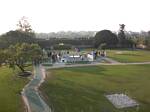 Raj Ghat, Mahatma Gandhi |
 Long entrance |
 Up close |
 At Raj Ghat |
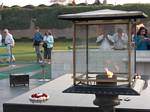 Eternal flame |

|
Click Here for Daisy's video explanation of Gandhi's divine status! |

Ganga Ma
Ganga Ma (Ganges River Mother) is truly the heart of India. Lucky for us, we had the opportunity to float the river at its most sacred place - Varanasi. 400 Million people live along the 2,510 kilometre (1,560 mile) length of the Ganges - from its headwaters in the Himalayas to its terminus in the Bay of Bengal.Varanasi has hundreds of temples along the bank (Ghat) of the Ganges which often become flooded during the rains. Varanasi is an important place of worship in addition to serving as a cremation ground. Indian Mythology states that Ganga, daughter of Himavan, King of the Mountains, had the power to purify anything that touched her. According to myths, Ganga flowed from the heavens and purified the people of India. After a funeral, and before cremation, Indians often immerse the bodies of their dead in the Ganga, which is believed to purify them of their sins - I think this explains why we also saw so many families pouring Ganges water directly into the mouths of loved ones who'd passed. It may also explain why we saw so many people drinking the river's water as well...

|
Click Here for my video of young monks practicing Yoga alongside Mother Ganges... |

Holy Cow
Although in India the cow is considered sacred or holy it is mostly Aghanya - that which may not be slaughtered. In Hinduism later sects began to call the cow "the mother" and even wrote some questionable scripture to support this, but the actual reverence comes from the cow's potential to provide milk. This "milk-debt" was culturally a very strong more, and it was felt that it would not be fair to leave the cow out of its share of respect for contributing to everyone's health.The Vedic period (when the scriptures were being written from about the second and first millennia BCE continuing up to the 6th century BCE) was a beef-eating one, and animals were constantly being slaughtered. With the birth of Jainism and Buddhism a cultural revolution took place transforming the country into a vegetarian state. The numerous pastoral tribes that inhabited India could not afford to sacrifice their cow wealth for meat - the real reason cows became Aghanya and inviolable.
Can you imagine being in a crowded market place and being politely nudged by a cow that's trying to pass? It happened to me, a couple of times, probably because I was standing around gawking too much - even for cows! Anyway, cows can be found anywhere throughout India - including inside of stores, shopping areas, temples, streets and everywhere else as evidenced by these photos. However, Delhi now forbids them in major parts of the city for obvious reasons - cows and multi-lane freeways just don't mix anymore!
The cows are fed by owners or by passersby wishing to make an offering. Oh, cow dung is collected, shaped into patties, and dried in the sun for use as a cooking fuel. The patties, when dried, don't emit any odor nor is there any smell when they're being burned.

|
Click Here for my video of one of many cows wandering the streets of India! |

Hinduism
Hinduism is the predominant religion of India and is known as "Sanatana Dharma" - a Sanskrit phrase meaning "the eternal law." Hinduism is the world's third largest religion after Christianity and Islam with approximately one billion adherents on the Indian subcontinent and southern Asia. Hinduism is considered the world's oldest living major religion with a belief system that varies widely by different groups of practitioners - ranging from pantheism, monotheism, to polytheism with Vishnu and Shiva being the most popular deities. Hinduism includes a belief in reincarnation and karma, as well as personal duty, or dharma.Although we visited various temples photography isn't allowed so I didn't end with as many pictures of the beautiful statuary and other objects that I would have liked. The swastika is an ancient religious symbol found throughout all of India an Buddhism - even painted at the entrance of homes or on the front of a truck or Tuk Tuk. Unfortunately the Nazi's added a stigma to the symbol even though their's is usually represented at a different angle. Anyway, the Swastika is still displayed with reverence throughout India - we've seen it painted at entrances, on vehicles, and in various religious settings.
Not to dwell on the sensational but I did ask if Indians were aware that their symbol, the Swastika, had been abused by the Nazis. Yes, Indians are aware of the abuse but point out that the Nazi's use of the symbol usually points in a different direction and is rotated somewhat. Either way, the Swastika brings Indians peace and protection and we, as visitors, grew accustomed to seeing it everywhere.
In Jaipur we enjoyed an evening service at a large, famous, and expensive Hindu temple (its name escapes me at this time...) in a very busy district. It was a lovely, moving service that was very welcoming despite our tourist status! At its conclusion, we were also allowed to participate in communion - sweet little sugary crystals handed to me by the priest.
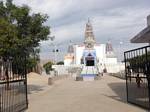 Hindu temple |
 Swastika |
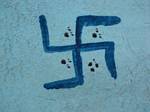 Swastika |
 Low door for bowing |

|
Click Here for an audio recording of from inside a Hindu temple (pix and video not allowed). |

|
Click Here for my video of Deepak explaining that God's name is truth! |

Buddhism
The learning center of Sarnath, at Varanasi, is where Siddhartha Gautama (The Buddha, or "awakended one") preached his first sermon to his disciples (as portrayed in Bernardo Bertolucci's film, Little Buddha). We felt fortunate to visit and walk the grounds where Buddha preached 2,400 years ago!
The Bodhi Tree of Sarnath (above) is planted from a sapling taken from the Sri Maha Bodhi tree of Anuradhapura, Sri Lanka. The sapling was planted on 12 November 1931 by the venerable Sri Devamitta Dhammapala, founder of Maha Bodhi Society of India, to mark the opening of the Mulagandha Kuty Vihara.

|
Click Here for a photograph of the four leaves picked from the sidewalk beneath the Bodhi Tree at Sarnath... |

Jainism
While at Khajuraho (next set of photos below) we visited a nearby Jain temple. Jainism is one of the oldest religions on the Indian subcontinent. Jains believe that every soul is divine and has the potential to achieve God-consciousness. Jains have an ancient tradition of scholarship and have the highest degree of literacy in India - their libraries being the oldest in in the country.Nonviolence is a huge part of Jainism and includes vegetarianism. Jains are expected to be non-violent in thought, word, and deed, both toward humans and toward all other living beings, therefore Jain monks and nuns walk barefoot and sweep the ground in front of them to avoid killing insects or other tiny beings.
In Jainism, male Digambara monks do not wear any clothes and are nude throughout their lives. They practice non-attachment to the body and hence, wear no clothes. Shvetambara monks and nuns wear white clothes. Although I was reluctant to photograph this monk I felt it important to illustrate their practice of not wearing clothing. This particular monk was wearing reading glasses - something that has only recently been accepted...
 Jain monk and worshiper |
 Jain monk, sans clothing... |
 Monk's study area |

Khajuraho
The Indian village of Khajuraho is located in the state of Madhya Pradesh, about 385 miles (620 kilometres) southeast of Delhi. Khajuraho's group of monuments has been listed as a UNESCO World Heritage Site and is one of the most popular tourist destinations in India despite a population base of only about 15,000 people when we were there (the area is mostly agricultural). Kharjuraho was built over a 200 year period between 950 and 1150 CE. There's evidence that Muslim invaders (sometime around 1100 to 1400 CE) destroyed parts of the 80 temples - after that, and with the encroachment of jungle, about 25 of the temples exist today.In the 19th century the British "discovered" Khajuraho and recovered it from the jungle for preservation (many Indians have advised me that historical preservation was one of the British strong points throughout their occupation of the subcontinent). Obviously the erotic sculptures attract people but the general theme, throughout must of Khajuraho, is just a representation of regular life in and around the temple area. In one scene, that is viewable on my YouTube video, you can even see a comic sculpture of two elephants coliding into a third that had stopped unexpectedly. Anyway, Kharjuraho is is interesting on many levels besides just the erotic art!

|
Click Here for my video alongside one of the erotic panels at Khajuraho... |

Taj Mahal
What trip to India would be complete with out seeing the magnificant Taj Mahal?? This grand edifice, built by Shan Jahan from 1631 to 1653 to enshrine the remains of his Queen Mumtaz Mahal, took 20,000 workers to build. We were able to walk into the inner chambers of this renowned "Monument to Love," seeking out several vantage points to see the magnificent play of light (that didn't come out too clear in my cheap camera!). The semi translucent white marble is inlaid with thousands of semi-precious stones in beautifu patterns and the building has four identical facades, a perfect exercise in symmetry. It's truly a wonder of the world!
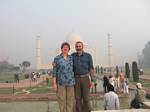 Taj Mahal |
 Visitors having fun |
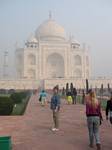 Taj Mahal |
 Hand-carved marble screen |
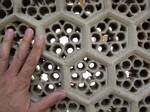 Hand-carved marble screen |
 Required booties |
 Repairing the Taj Mahal |
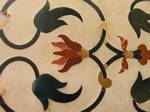 Fine inlay |
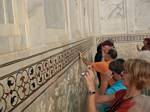 Inlay |
 Daisy on the tile |
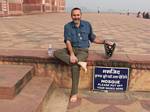 Me entering the Mosque barefoot |
 Mosque at the Taj Mahal |
 At the Mosque |
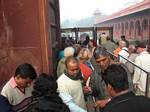 Taj Mahal entrance security |
 Taj Mahal |

|
Click Here for a video of folks having fun while walking up to the Taj Mahal... |

|
Click Here for my India "Two" overflow page! |


|
I've posted over 100 of my videos from India on YouTube. The following is a list of the ones that may be of the most interest: |

Links:
|
 An Indian visa cost $113 USD in 2008... |

 Back to Roger J. Wendell's Home Page...
Back to Roger J. Wendell's Home Page...
Abbey |
About |
Blog |
Contacting
Me |
Copyright |
Disclaimer |
Donate |
Guest
Book |
Home |
Links |
Site
Index |
Solutions |
Terms,
Conditions
and
Fair
Use |
What's
Changed
or
New?
Copyright
© 1955 -